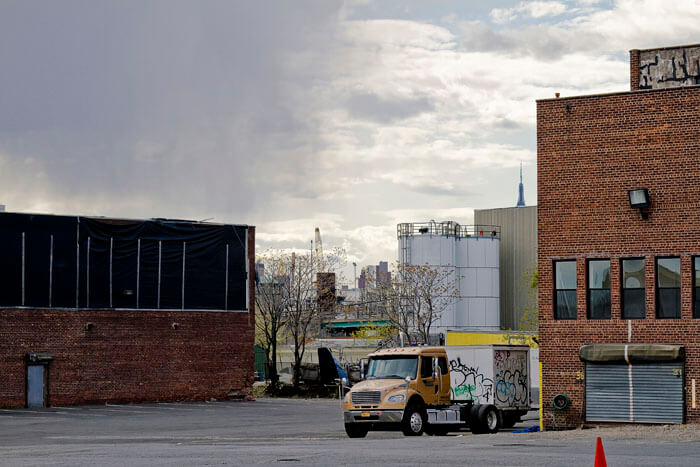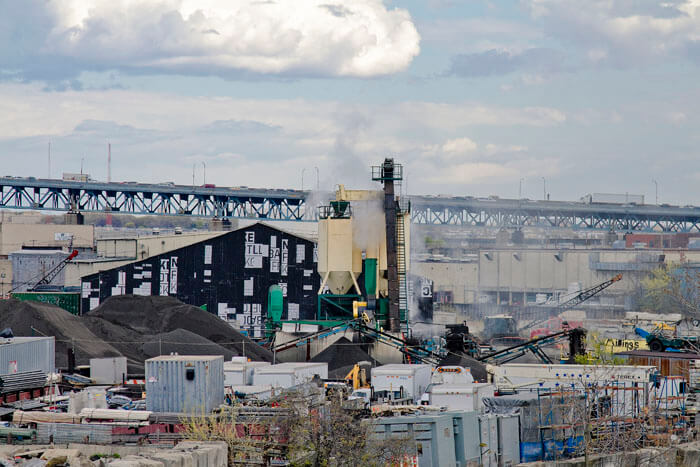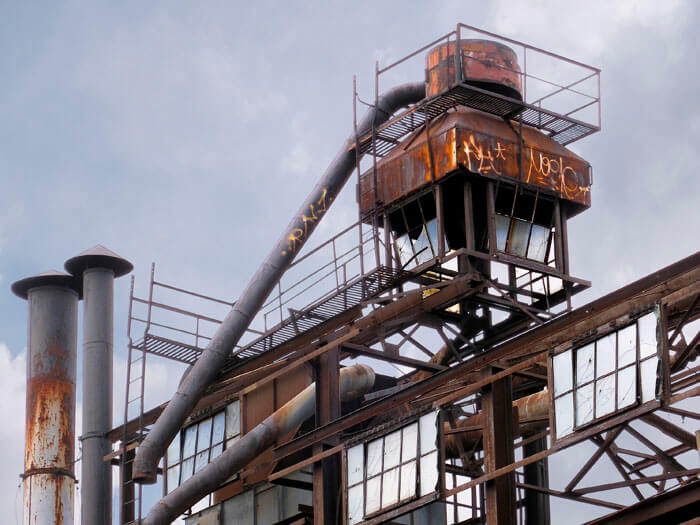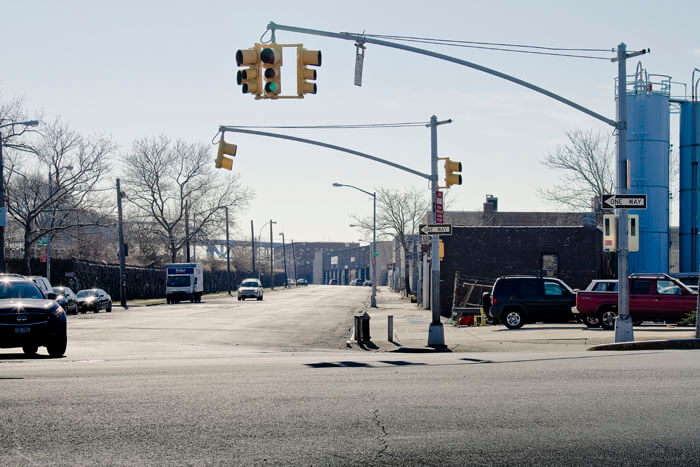Van Iderstine: A Vegetarian's Worst Nightmare
“It’s a meat grinder over there” is a phrase and analogous statement often used by modern pundits to describe a past or present war, firefight, or even a less than welcoming part of the Bronx. Conjuring imagery of familiar butcher tools spewing out hamburger meat, the term means something else entirely to those versed in…

Photo by Mitch Waxman
“It’s a meat grinder over there” is a phrase and analogous statement often used by modern pundits to describe a past or present war, firefight, or even a less than welcoming part of the Bronx.
Conjuring imagery of familiar butcher tools spewing out hamburger meat, the term means something else entirely to those versed in the lore of an infamous cataract known as the Newtown Creek.
To those who have stared too long at the blasted heaths of Blissville at the border of Brooklyn and Queens from the bulkheads of Newtown Creek or from atop the Greenpoint Avenue Bridge, “It’s a meat grinder over there” refers to a certain spot in DUGABO (Down Under the Greenpoint Avenue Bridge Onramp), whose mention engenders a sudden display of wan or pale complexions upon the faces of longtime area residents merely at the utterance of its shunned name.
Van Iderstine.
From 1875’s “Report of the Department of Health of the City of Brooklyn, N.Y.,” courtesy Google Books:
FAT RENDERING.
In this process animal fat, obtained from the slaughter-houses and butcher-shops, is exposed to sufficient heat to liquefy it. The resulting tallow is removed to settling-vats, and finally tacked in suitable casks to harden. Up to within the past lew years the methods in use were of the most primitive description, the fatty material being placed in open kettles and heat applied at the bottom. As during the heating of the mass very offensive odors are given off, consisting of sulphureted and phosphureted hydrogen and ammoniacal gases, repeated complaints were caused, and it became necessary to adopt some method of correcting the evil.
The most improved methods dispose of the noxious goses by combustion or condensation. The latter is the one adopted by the factories in this district, and consists of the following process. The fatty material is placed in a steam-tight tank (Lockwood & Everett’s), capable of holding about ten thousand pounds; the tank is double, being, in fact, a smaller tank within a larger. The fat is contained in the inner compartment, while the outer is used for holding the steam. On applying the steam heat, pressure is originated in the mass, and the offensive gases thereby forced through a condensing-pipe into Newtown creek below low-water mark. The tallow at a certain stage is passed by its proper pipe to a large open vat, from which it is dipped into casks. The residue, known as “scrap,” is subsequently removed through a trap in the bottom of the tank, and being pressed is sold for fertilizing purposes.
By this method all offense appears to be prevented, and the manufacture might be carried on without prejudice in a built-up portion of the city.
In this district there are three rendering factories of any importance, all situated on Newtown Creek, near Greenpoint Avenue. The owners are F. A. Van Iderstine, S. Rosenbaeh and John Van Iderstine.

Chicago’s Phillip Armour, whose industrial methodology was contemporaneously described as “using every part of the pig except the squeal,” set a standard for the industrial exploitation of animals. Inedible parts of farm or food livestock, spoiled meat or rancid chicken eggs, dead animals such as equines, canines, feral cats — even the collected blood from slaughterhouse killing floors was (and is) a valuable commodity.
Rendering companies receive this organic “raw material” from butcher shops, slaughterhouses, dog pounds, and veterinarians.
In the days of horse and ox drawn carriages, thousands of dead pack animals found their way to the Van Iderstine mills, which seemed to specialize in the disposition of larger mammals.
I haven’t been able to locate a primary source for this not locked up behind a paywall, yet, but they were apparently the “go to” for handling dead elephants in the City of New York.
From fire-police-ems.com:
In the early days any animal which died on the streets of New York, such as horses that pulled wagons, circus animals, some as huge as elephants, that died when the circus came to town, were taken to the Van Iderstine Factory. There, they were put into a giant funnel set-up that had huge meat grinders at the bottom which ground up their bodies. These smaller more manageable pieces were brought to other buildings on the large factory premises where the fat was rendered to make soap and glue.
Van Iderstine trucks would also go to butchers all over the city to buy their waste fat and bones.

The early Van Iderstine story is obscured behind distaste for their long presence in the community, as the company was reviled on both sides of the Creek for the odors which they produced, but they arrived in the area just after the Civil War. An odd thing, considering they were a major employer and — in one corporate guise or another — the operation was in this spot for a just over a century. Everybody I speak to that grew up in LIC or Greenpoint had an uncle or brother-in-law who worked there at one time or another.
That’s an asphalt company in the shot above, which is found in modernity at the extreme eastern side of the Van Iderstine property, with the New York Paving Company occupying the western section adjoining the Greenpoint Avenue Bridge. Right next door was one of Charles Pratt’s oil refinery operations, The Queens County Oil Works.
A fire in 1964, coupled with a rising tide of community activism, is said to have led to the company’s abandonment of the site and eventual move to Newark, New Jersey.
From Wikipedia:
The rendering industry is one of the oldest recycling industries, and made possible the development of a large food industry. The industry takes what would otherwise be waste materials and makes useful products such as fuels, soaps, rubber, plastics, etc. At the same time, rendering solves what would otherwise be a major disposal problem. As an example, the USA recycles more than 21 million metric tons annually of highly perishable and noxious organic matter. In 2004, the U.S. industry produced over 8 million metric tons of products, of which 1.6 million metric tons were exported.
Usually, materials used as raw materials in the rendering process are susceptible to spoilage. However, after rendering, the materials are much more resistant to spoiling. This is due to the application of heat either through cooking in the wet rendering process or the extraction of fluid in the dry rendering process. The fat obtained can be used as low-cost raw material in making grease, animal feed, soap, candles, biodiesel, and as a feed-stock for the chemical industry. Tallow, derived from beef waste, is an important raw material in the steel rolling industry providing the required lubrication when compressing steel sheets. The meat and the bones (which are in a dry, ground state) are converted to what is known as meat and bone meal. For many years meat and bone meal were fed to cattle. This practice is now prohibited in developed countries because it is believed to be the main route for the spread of bovine spongiform encephalopathy (mad-cow disease, BSE), which is also fatal to human beings. Meat and bone meal from cattle is, however, fed to non-ruminant animals and meat and bone meal from non-ruminant animals is fed to cattle in the United States. This may not prove to be a solution to the problem due to the resistant nature of the infectious agent of BSE, a misfolded protein (prion). Therefore, even if cattle is fed to non-ruminant animals and vice-versa, it will not prevent BSE from occurring. The underlying cause is that the prion survives within the system of the animal that has been fed with meat and bone meal from different animals including cattle. These animals are then eventually rendered and fed to cattle, which also results in the development of the disease.

Effluents, miasma and all sorts of ugly “humours” hung in the air around the Van Iderstine Mill. A complex of buildings, there would have been dozens of dark blue trucks waiting to tip their loads into the yard. Workers would have sorted fester from boil, fat from bone, and would have had to be quick with both saw and hook to survive at the job long, along with possessing a startling ability to ignore the blasting and pestilential stink of decay.
The LIRR tracks, of course, run right alongside the property and provided the factory with freight service. These tracks were also used by passenger trains heading east from Hunters Point. It’s common in the historical record to read about perfumed handkerchiefs being deployed by its passengers in the 19th century when the train debarked from the Hunters Point station for points east.
One colorful description of experiencing a Van Iderstine driveby in one of these passenger trains advanced that the writer’s first impression of the distant scene was that a series of smoky campfires had been lit at Van Iderstine, as evidenced by long plumes of black smoke trailing into the evening sky.
When the train approached the plant, he realized that the “smoke” was actually billions of flies descending, swarming, and spiraling in on the yard from the swampy wetlands found east of the spot, past the Haberman siding nearby Maspeth Creek.
From epa.gov:
Volatile organic compounds (VOCs) are the primary air pollutants emitted from rendering operations. The major constituents that have been qualitatively identified as potential emissions include organic sulfides, disulfides, C-4 to C-7 aldehydes, trimethylamine, C-4 amines, quinoline, dimethyl pyrazine, other pyrazines, and C-3 to C-6 organic acids. In addition, lesser amounts of C-4 to C-7 alcohols, ketones, aliphatic hydrocarbons, and aromatic compounds are potentially emitted. No quantitative emission data were presented. Historically, the VOCs are considered an odor nuisance in residential areas in close proximity to rendering plants, and emission controls are directed toward odor elimination. The odor detection threshold for many of these compounds is low; some as low as 1 part per billion (ppb). Of the specific constituents listed, only quinoline is classified as a hazardous air pollutant (HAP). In addition to emissions from rendering operations, VOCs may be emitted from the boilers used to generate steam for the operation.

Sensational hyperbole is what it seems to be.
Nearly every reference to Van Iderstine and the other renderers in Blissville, or distilleries like Fleischman Yeast, involves a court case or ordinance condemning them. Rest assured that the horror stories, in particular the ones offered by the NY State Board of Health (considered to be sworn testimony), are likely true depictions of what went on around here. Reports from community members old enough to remember the operation are less than glowing and confirm all of the stories which the 19th century supplies.
Often, I am informed that the surrounding communities celebrated when the last of the renderers went and the oil refineries came in.
From 1894’s “Public Papers of Roswell P. Flower, Governor” courtesy Google Books:
A continuous nuisance of a serious character is caused, (a) by Hildebrandt’s Works, located on Furman’s Island, just north of Wissel’s offal dock. This is a small wooden structure where blood and animal refuse matter are treated in an open kettle; (b) by the following rendering establishments: Preston’s Fertilizer and Rendering Works; Peter Van Iderstine, Jr.’s Fat Rendering Works; F. A. Van Iderstine’s Rendering Works; Fred. Heffners Fat Rendering Works.
These rendering establishments depend upon the water of the creek for water supply to furnish their condensers. The latter are used to condense the gases and vapors given off during the process of rendering. These gases and vapors, condensed and held in solution and in suspension in the water, are discharged into the creek with the discharge from said condensers. The creek water is utterly unfit for this purpose, and the creek itself is unfit to receive such discharge, which, under the conditions now existing thereat, is a source of nuisance that can only be abated by closing the rendering works named in this section, or by a radical change in the present method of disposing of the gases in question. The latter, under the circumstances, is not practicable.
Newtown Creek Alliance Historian Mitch Waxman lives in Astoria and blogs at Newtown Pentacle.





hey, its a good business. Darling International stock is making all time highs. The pet food industry is on fire!
That was fascinating, Mitch. Disgusting, but fascinating, nonetheless. Great research and well done!